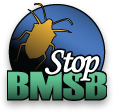Behavioral- and Landscape-Based Management
Attract and Kill
 |
|
Dead stink bugs on an attract-and-kill tree. Photo: Rob Morrison. |
The theory behind attract-and-kill is to lure pests to a precise location and kill them there. The point is not to have to spray an entire field or orchard, thus significantly reducing the amount of insecticide used, and therefore saving money and reducing risks of environmental side-effects.
Rob Morrison, a research entomologist with the USDA-ARS Center for Grain and Animal Health Research, describes a method for baiting select border-row trees with an aggregation pheromone of the brown marmorated stink bug.
IPM-CPR (Integrated Pest Management Crop Perimeter Restructuring)
 The brown marmorated stink bug (BMSB) has disrupted long-standing tree fruit IPM programs resulting in changing management practices to combat the threat posed by this invasive pest. Current management tools for BMSB rely on weekly, season-long applications of broad-spectrum insecticides that are costly, risk pest resistance, and may cause secondary pest outbreaks. The goal of IPM-CPR is to re-introduce common IPM practices (phenology based, reduce risk insecticide usage, mating disruption, and biological control) back into tree fruit management. The implementation of IPM-CPR for the management of key tree fruit pests may be less costly, more sustainable, enhance biological control, and be just as effective as current standard management methods.
The brown marmorated stink bug (BMSB) has disrupted long-standing tree fruit IPM programs resulting in changing management practices to combat the threat posed by this invasive pest. Current management tools for BMSB rely on weekly, season-long applications of broad-spectrum insecticides that are costly, risk pest resistance, and may cause secondary pest outbreaks. The goal of IPM-CPR is to re-introduce common IPM practices (phenology based, reduce risk insecticide usage, mating disruption, and biological control) back into tree fruit management. The implementation of IPM-CPR for the management of key tree fruit pests may be less costly, more sustainable, enhance biological control, and be just as effective as current standard management methods.
 IPM-CPR (Integrated Pest Management Crop Perimeter Restructuring)
IPM-CPR (Integrated Pest Management Crop Perimeter Restructuring)
Updates, Findings, and Related Resources
Participate in a nationwide survey to gather information from farmers and growers on the economic impact of the brown marmorated stink bug (BMSB) on agriculture.
January 8, 2018 New Ingredient Improves Pheromone Lure for Brown Marmorated Stink Bug
Researchers at the USDA’s Agricultural Research Service have identified a chemical that enhances capture of the brown marmorated stink bug in pheromone traps when combined with other existing known attractants for the invasive pest. Source: Entomology Today, Jan. 8, 2018.
